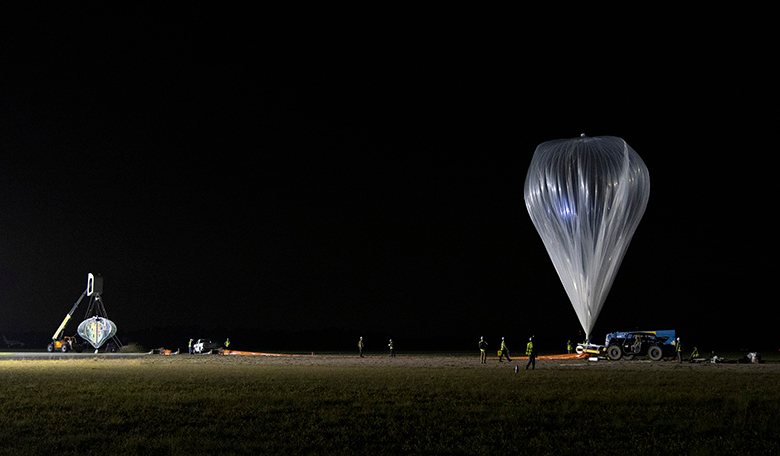Space Perspective today announced that its Neptune One spaceship test vehicle successfully launched from the Space Coast Spaceport, located adjacent to NASA’s Kennedy Space Center. The vehicle flew to its target altitude and traversed the Florida peninsula before splashing down in the Gulf of Mexico and being recovered. The historic 6 hour and 39-minute flight marks the first major step towards flying customers to space for an unrivalled experience and perspective of our world from space.
Neptune One launched at 5:23 am EDT from the Space Coast Air and Spaceport and reached its planned altitude of 33043 metres (108,409 feet) before executing a splashdown at the predetermined location 80 kilometres (50 miles) off the west coast of Florida. With this flight, Space Perspective became the first space launch operator to fly from the Space Coast Spaceport.
“I could not be more proud of the performance of the team and the flight system. It was spectacular to witness the teamwork and the high level of expertise yield such a successful result,” said co-CEO and founder Taber MacCallum.
“It is an incredible privilege launching from the space coast, where the history of human spaceflight was forged over the past decades and continues to build momentum today. Flying on Spaceship Neptune will be an extraordinary experience for our Space Explorers,” said co-CEO and founder Jane Poynter.
Space Perspective flew a full-size capsule simulator with the same geometry as Spaceship Neptune’s capsule. All primary objectives of the test flight were met. Ultimately, the most important objective was the completion of a full flight demonstration, from prelaunch to recovery.
“This test flight of Neptune One kicks off our extensive test flight campaign, which will be extremely robust because we can perform tests without a pilot, making Spaceship Neptune an extremely safe way to go to space,” added MacCallum.
“Space Florida congratulates Space Perspective on today’s first test flight of its revolutionary spaceballoon capability, and for being the first space launch operator to fly from the Space Coast Spaceport, Florida’s newest spaceport. This flight highlights the reality of Florida again at the leading edge in space research, tourism, and commercial capabilities. We look forward to the coming milestones for Space Perspective as they prepare to take private citizens to space,” said Frank DiBello, president and CEO of Space Florida.
This test flight flew a number of payloads, including:
- Higher Orbits, an educational nonprofit that uses space to promote STEAM by partnering with astronauts and students, flew the winning projects of their recent science project competition for students grades 7-12. One experiment measured the sun’s magnetic field to confirm solar minimum, the time when the sun is least active. A second measured the effects of the space environment on memory materials that are made to hold a particular shape. Their payload also included winners of their current art competition, open to all ages, illustrating Space Perspective’s goal to show that exploring the world we live in and communicating the human experience is possible in ways that engineering and technology cannot.
- University of Northern Florida flew an ozone sensors instrument, developed by Dr. Nirmal Patel and his students’ team in the physics department, to test their innovative atmospheric science technology. This payload demonstrates to research organizations, NASA and other government entities that Spaceship Neptune is a valuable platform for research.
- In addition, two other technical partners, Valispace and International Met Systems Inc., provided engineering and meteorology tools in support of the test flight.
Space Perspective, founded in 2019, was created to make spaceflight more accessible to all, and to provide the thrilling opportunity to see Earth as a planet in space. Spaceship Neptune was developed from the onset for maximum safety, accessibility, near zero-emissions and routine operations around the world. The spaceballoon could hold an entire football stadium when inflated and the pressurized capsule is comfortable and spacious.
Flown by a pilot, Spaceship Neptune transports eight passengers, called “Space Explorers,” on a thrilling six-hour journey to space, along with research payloads.
The two-hour gentle ascent above 99 percent of the Earth’s atmosphere to 30480 metres (100,000 feet), Spaceship Neptune glides above the Earth for up to two hours allowing passengers to share their experience via social media, with their friends and family.
Spaceship Neptune then makes a two-hour descent under the spaceballoon and splashes down, where a ship retrieves the passengers, the capsule, and the spaceballoon. Spaceship Neptune’s commercial human spaceflight launches are regulated by the FAA Office of Commercial Spaceflight.
Images of the flight launch can be found on Space Perspective’s website.











